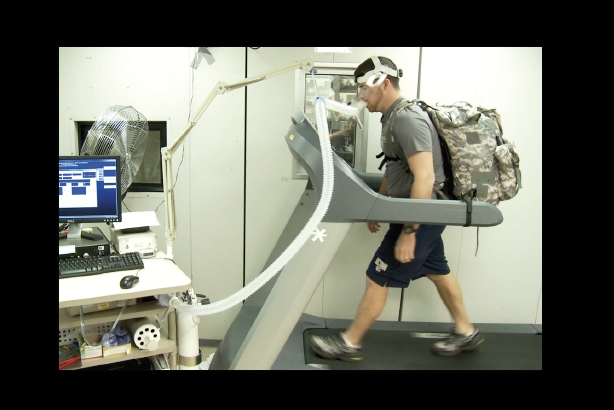
STORRS, Conn. — Douglas Casa acknowledges his new heat laboratory at the University of Connecticut’s Korey Stringer Institute could be viewed by some as a torture chamber.
He’ll be testing athletes, soldiers and others (sometimes for hours at a time) on a treadmill, stationary bike or cooling tub in an environment that can be controlled to reach temperatures of up to 110 degrees and 90 percent humidity.
“The difference is, everyone being tested here is a volunteer,” he said. “And we’re saving lives.”
The $700,000 Mission Heat Laboratory is designed to be used by the NFL, NCAA teams, the military, apparel manufacturers, and scientists interested in preventing and treating heat-related illnesses, optimizing performance in extreme conditions, and learning the temperature limits of the human body.
“The prevention side of heat stroke is one of the big reasons this lab was built,” Casa said. “We can look at things related to hydration, body-cooling strategies, acclimatization and the effects of certain medications, supplements and clothing on how much you heat up.”
Casa decided to make the study of heat and the human body his life’s work after nearly dying of heat stroke while competing in a 10K race at the Empire State Games in 1985.
He helped found the Korey Stringer Institute in 2010, after being approached by the family of the former Minnesota Vikings lineman who died of a heat stroke in 2001.
The institute’s work has helped rewrite heat-related protocols for the military along with the NFL, college football and other sports. Casa’s research, for example, proved that treating a heat stroke immediately on site to bring a body’s temperature down below 104 degrees can dramatically increase survival rates. That led to NFL teams putting cooling tubs at practice sites.
But Casa’s team had been working in a tiny 100-square-foot closet-like lab, using household humidifiers and dehumidifiers to conduct their research. Some of the lab’s ceiling tiles had to be removed to accommodate one of the taller athletes they tested.
UConn provided about $350,000 for the new high-tech lab with its environmental controls, $20,000 treadmills and computer monitoring equipment. It even has a bathroom so test subjects don’t have to leave the controlled environment during longer sessions.
The other half of the lab’s funding came from donors including the NFL, its players association and athletic trainers’ organization. Mission, an athletic apparel company co-founded by tennis star Serena Williams, basketball star Dwayne Wade and soccer star David Villa, spent $100,000 to secure the naming rights.
Josh Shaw, Mission’s chief executive, said it plans to use the lab to test new garments that will not only wick moisture from the body, but eliminate it from the clothing entirely. The lab also will be used to test new wearable technologies, sensors that can be placed in T-shirts for example, that could alert someone when they begin overheating.
“Serena Williams competes at 120 degrees at the Australian Open, that’s pretty extreme,” Shaw said. “So, if we can create a product that will help her be safe, we’re probably going to be able to use that technology for people, say, who do roofing or gardening, or contracting.”
The military, which has similar labs, is working in conjunction with Casa and Korey Stringer to conduct tests on people and materials to optimize how soldiers perform in places such as the Middle East, and determine whether certain people are fit for duty in the heat.
“Understanding different stresses in the heat, whether it’s combat load or uniforms that can be mitigated with different materials, different load carriages, different hydration or cooling strategies — those are things we can work out in the lab before they are worked out in the field,” said. Dr. Francis O’Connor, a retired colonel who studies heat-related issues at Uniformed Services University.
The lab also will be used by UConn’s athletic teams to help them prepare for hot-weather competitions and by individual athletes who have suffered heat-related illnesses to help them determine their new heat tolerances levels and develop a recovery plan.
Offensive lineman Hunter Knighton credits the institute with getting him back on the football field following a near-fatal heat stroke during an offseason practice at the University of Miami in 2014. His family donated money for the new lab.
“It’s been kind of a miracle for me,” said Knighton, who now plays for Tulsa. “I was just really blessed to be able to find the institute and Dr. Casa. They were able to guide me back.”










